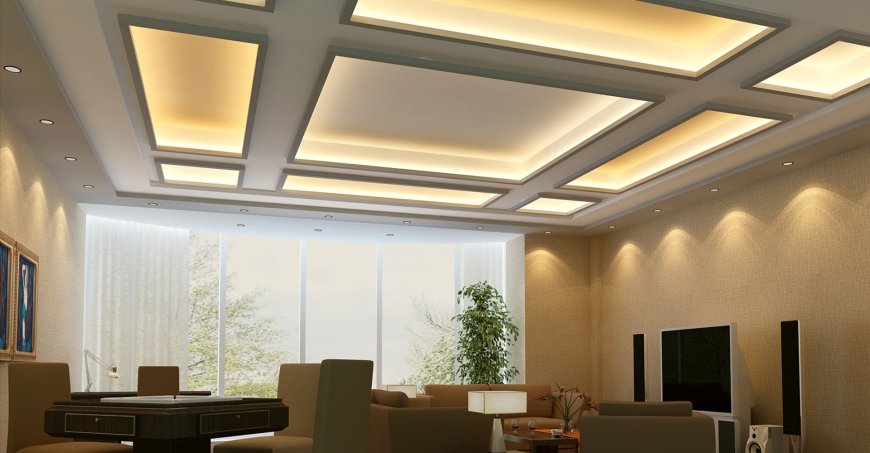Gypsum Board Ceiling vs. POP: Which One Is Better for Your Home?
Confused between gypsum board and POP for your ceiling? Compare cost, durability, finish, and more to decide what's right for your home.

Introduction
If youre planning a ceiling upgrade or designing a new space, choosing between gypsum board and POP (Plaster of Paris) can be a critical decision. Many homeowners today prefer hiring professional gypsum work services for modern interiors, while some still trust the traditional POP finish. But which one truly fits your needs?
This detailed comparison will walk you through the pros, cons, and practical differences between the two ceiling materialshelping you make an informed, budget-conscious, and design-smart choice.
Understanding the Basics
What Is Gypsum Board Ceiling?
Gypsum board, also known as drywall or plasterboard, is a prefabricated material made from calcium sulfate dihydrate. These boards are factory-made and come in standardized sizes, making them easy to install on metal or wooden frameworks.
What Is POP Ceiling?
Plaster of Paris is a powdered material derived from heating gypsum. When mixed with water, it forms a paste that can be molded and shaped. POP ceilings are created on-site and often hand-applied to frameworks or mesh.
1. Installation Time and Process
Gypsum Board Ceiling
-
Prefabricated boards allow faster installation.
-
Minimal site mess and consistent results.
-
Requires metal framing, joint tapes, and screws.
-
Ideal for tight project timelines.
POP Ceiling
-
Time-consuming as its handcrafted on-site.
-
Requires drying time and skilled labor.
-
Higher chances of inconsistent or uneven finish.
-
Suitable for projects with flexible schedules.
? Winner: Gypsum board (for speed and consistency)
2. Finish and Appearance
Gypsum Board
-
Offers a sleek, uniform look.
-
Seamless joints can be achieved with proper finishing.
-
Great for modern, minimalist designs.
POP
-
Allows for intricate moldings and artistic detailing.
-
Better for ornamental ceiling designs like cornices and motifs.
? Winner: Tie (Gypsum for clean finish, POP for detailing)
3. Durability and Strength
Gypsum Board
-
Strong and resistant to minor impacts.
-
Can sag over time if improperly installed or in high humidity areas.
-
Moisture-resistant variants are available.
POP
-
More durable when applied correctly.
-
Does not sag easily and holds up well over time.
-
Slightly more resistant to wear and tear.
? Winner: POP (if craftsmanship is excellent)
4. Flexibility in Design
Gypsum Board
-
Supports recessed lighting and layered false ceiling designs.
-
Limited flexibility in creating fine decorative patterns.
-
Available in moisture, fire, and acoustic variants.
POP
-
Extremely flexible in creating custom designs, curves, and cornices.
-
Can be molded into any shape or thickness.
-
Popular for traditional and artistic ceiling concepts.
? Winner: POP (for artistic flexibility)
5. Cost Comparison
Gypsum Board
-
Slightly more expensive than POP.
-
Cost includes materials and labor for framing and board fixing.
-
Lower wastage reduces long-term costs.
POP
-
More affordable material-wise.
-
Labor-intensive, so skilled worker charges can increase.
-
Prone to more on-site wastage.
? Winner: POP (for budget projects, gypsum offers value over time)
6. Maintenance and Longevity
Gypsum Board
-
Low maintenance when installed with care.
-
Needs repainting over time, but easy to repair.
-
Moisture can damage non-resistant types.
POP
-
Durable and hard surface resists minor dents.
-
Difficult to repair cracks or major damage.
-
Long-lasting but sensitive to water damage.
? Winner: Gypsum board (for ease of maintenance)
7. Environmental Impact
Gypsum Board
-
Made with recycled materials in many cases.
-
Lower carbon footprint due to factory production.
-
Non-toxic and safe for indoor environments.
POP
-
Energy-intensive manufacturing process.
-
Non-biodegradable and produces more on-site waste.
? Winner: Gypsum board (for eco-friendliness)
Which One Should You Choose?
Choose Gypsum Board If You:
-
Prefer quick and clean installation
-
Want a minimalist and modern look
-
Need moisture or fire resistance
-
Plan to use recessed lighting
Choose POP If You:
-
Desire detailed artistic work
-
Have skilled craftsmen available
-
Are working within a tight budget
-
Dont mind a longer installation time
Conclusion
Both materials have their unique strengths. While gypsum work services offer faster, cleaner, and more sustainable results, POP remains a strong contender for creative and detailed ceiling work.
Your decision should depend on your design goals, budget, and project timeline. If youre looking for a modern, efficient, and low-maintenance option, gypsum board ceiling is the better choice. On the other hand, if intricate patterns and handcrafted details are your priority, POP might be worth the wait.
Ultimately, a consultation with a professional can help you decide the best ceiling solution tailored to your space and style.
















![Top 9 Real Estate Mobile App Developers in Riyadh, Saudi Arabia [2025 Edition]](https://www.biphoo.uk/uploads/images/202507/image_430x256_6879d0d524335.jpg)


















